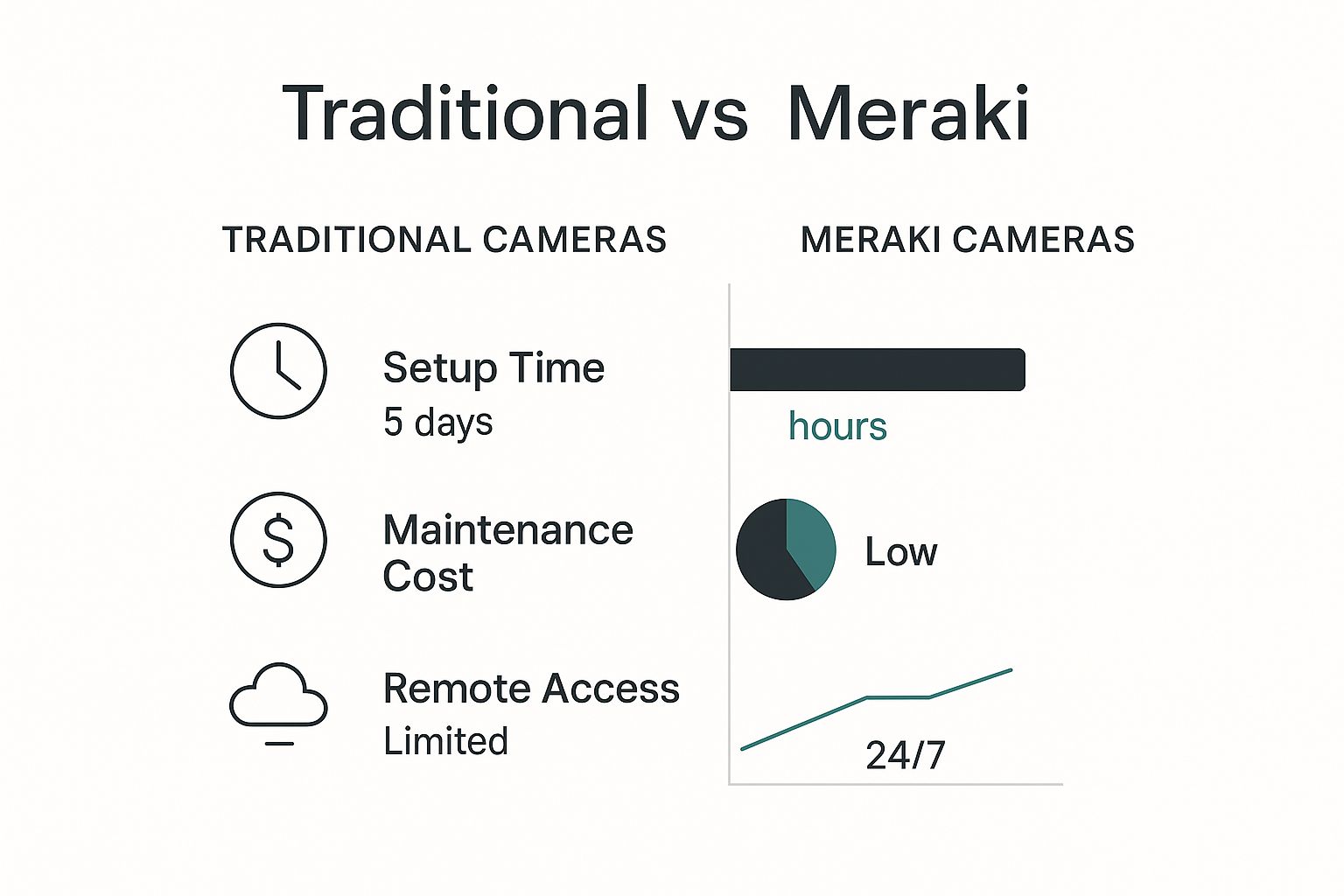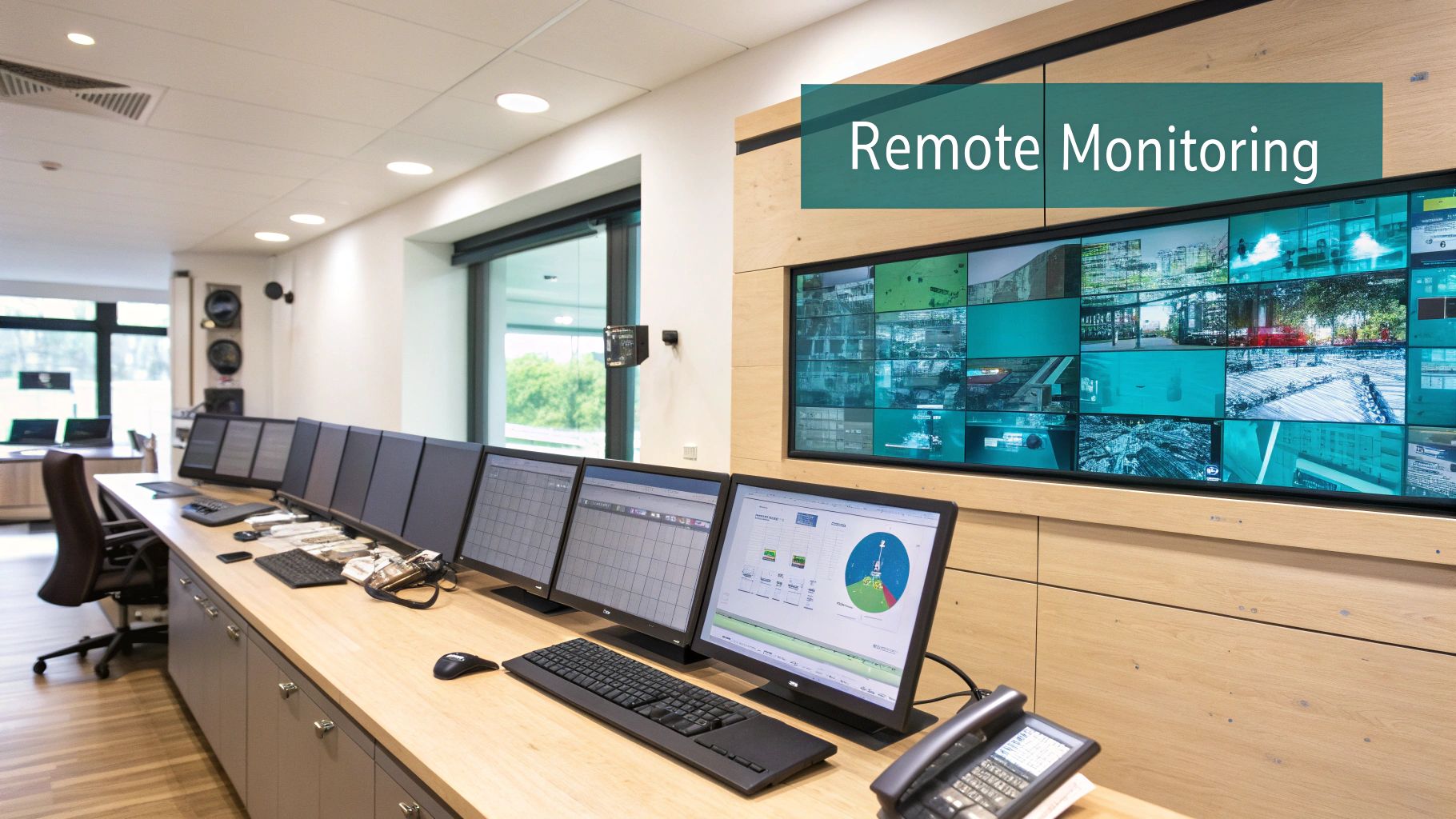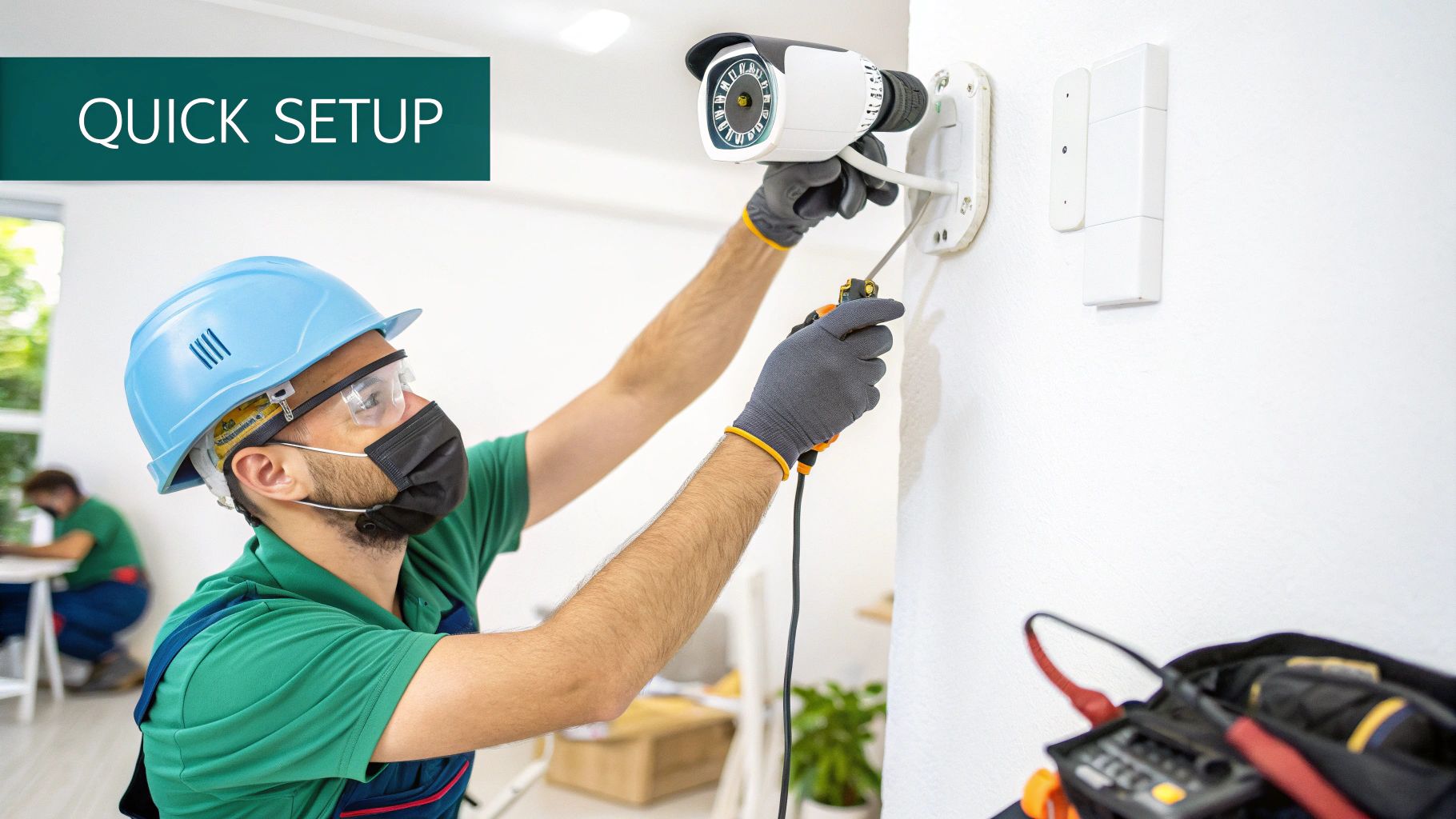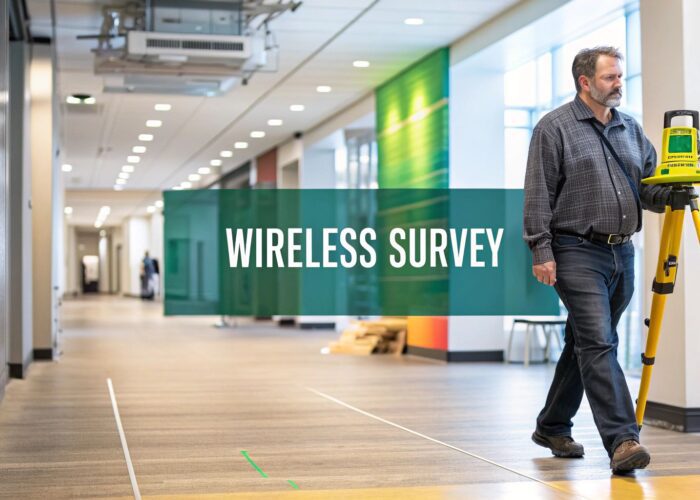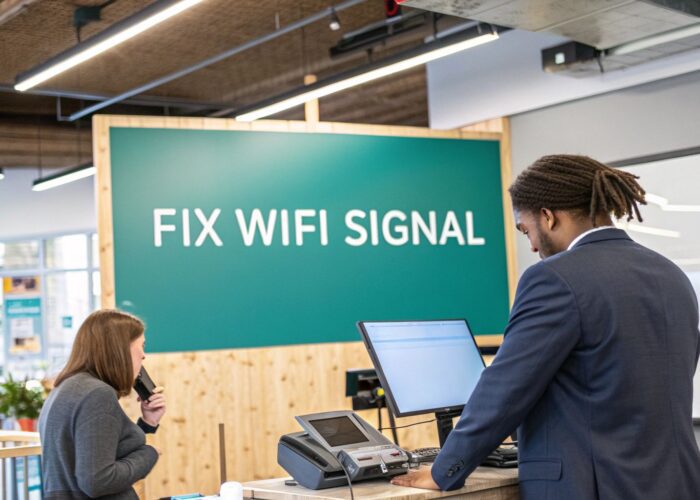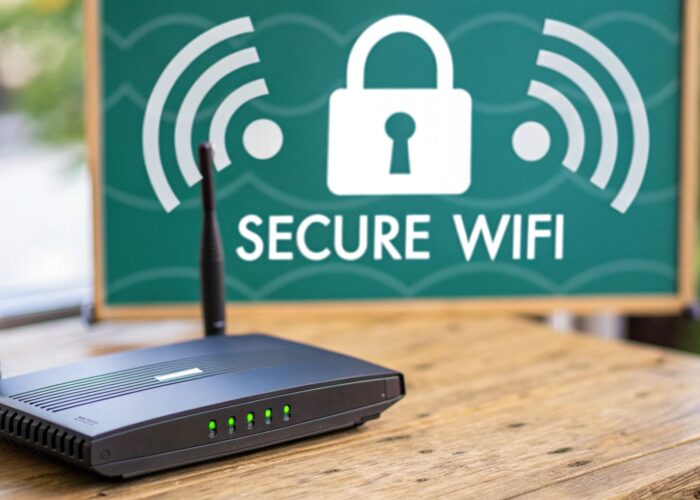Hey there! Welcome to the future of physical security. Let's talk about something cool: Meraki security cameras. Think of them as intelligent, cloud-managed devices that bring incredible simplicity to surveillance for businesses of all sizes. Forget the complex, clunky systems of the past; we’re talking about smart cameras that are literally as easy to set up as plugging in a cable.
Rethinking Security With Meraki Cameras
Let's be honest, modern security is about more than just hitting "record." It requires a smarter, more proactive approach. The entire security camera market is shifting in this direction, with analysts expecting it to grow at a compound annual growth rate of 8.9% from 2025 to 2032. This boom is being fueled by new advancements in AI-powered analytics and cloud technology.
This guide will walk you through what makes Meraki security cameras so different and show you how advanced Cisco Meraki solutions are truly redefining physical security.
The big idea behind the Cisco Meraki ecosystem is centralization. Imagine managing your entire security network—whether for a single Retail shop or a massive Education campus—from one clean, simple online dashboard. That’s the magic of Meraki.
One of the most significant departures from old-school systems is the complete elimination of bulky, on-site recorders like DVRs and NVRs. This immediately cuts down on hardware costs and maintenance headaches, but more importantly, it removes a single, critical point of failure. You can learn more about the compelling reasons to ditch this outdated hardware and discover more reasons to say no to NVRs.
Traditional vs Meraki: A Clear Comparison
The operational differences really come to life when you put them side-by-side. Traditional camera systems almost always involve complex configurations, juggling multiple vendors, and a serious time investment just to get things running.
Meraki, on the other hand, was designed from the ground up for simplicity, but without compromising on power.
To paint a clearer picture, let's break down the core advantages that define the Meraki camera experience. The table below offers a straightforward summary of where Meraki’s cloud-managed model really pulls ahead of traditional setups.
Meraki MV Cameras At a Glance
| Feature | Meraki Cloud-Managed Approach | Traditional Security Systems |
|---|---|---|
| Setup & Deployment | Plug-and-play. Cameras are online in minutes with zero-touch provisioning. | Often requires manual IP configuration, on-site servers, and complex software installation. |
| Management | Single web-based dashboard. Manage all cameras and settings from anywhere in the world. | Relies on local NVR/DVR software, often requiring on-site access or clunky VPNs. |
| Storage | Onboard solid-state storage. Eliminates the need for a separate NVR/DVR, reducing cost and failure points. | Centralized NVR/DVR is a single point of failure and a maintenance headache. |
| Scalability | Effortless. Add a new camera to the network by simply plugging it in and claiming it in the dashboard. | Adding cameras can require new hardware, licensing, and significant reconfiguration. |
| Firmware & Security | Automatic updates. Patches and new features are pushed seamlessly from the cloud. | Manual firmware updates are required, often leaving systems vulnerable. |
As you can see, the cloud-managed model isn't just a minor improvement—it’s a fundamental shift in how security systems are deployed and maintained.
This infographic really drives home the key differences in setup time, ongoing costs, and accessibility between the two approaches.
It's clear how centralizing management and making deployment foolproof lets IT teams stop putting out fires and start focusing on proactive security.
Beyond Security: WiFi and Authentication
The real power of the Meraki platform is how it extends beyond just video. When you pair these cameras with Cisco Meraki WiFi, they become part of a single, unified network infrastructure. This kind of integration is a game-changer for Education, Retail stores, and any BYOD Corporate office.
Having a cohesive system enables much smarter security and network management. For example, data from a camera's analytics can actually help inform and shape your WiFi policies. This synergy is crucial for modern networks where you need robust Authentication Solutions.
By combining intelligent cameras with robust network access control, organizations can build a truly secure and responsive environment. This synergy is key to managing the diverse devices found in today's corporate and educational settings.
Methods like Identity Pre-Shared Key (IPSK) and EasyPSK make it easy to provide secure, granular access for different groups, whether they're students or staff. When a user connects to the WiFi through a Captive Portal, their access can be tailored and monitored, ensuring only authorized devices ever touch your network. This is how you get an enterprise-grade security posture that is both incredibly powerful and surprisingly easy to manage.
Cloud Management and Dead-Simple Deployment
The real magic behind Meraki security cameras is how they’re managed. Everything lives in the cloud, which completely changes the game for security system deployment and day-to-day operations. Forget about dedicated servers and complicated software—your entire system is controlled through the simple, web-based Cisco Meraki dashboard.
Seriously, the setup is almost unbelievably easy. You just plug the camera in. That’s it. It automatically phones home to the cloud, pulls down its configuration, and just appears in your dashboard, ready to go in minutes. No IP address wrestling, no software to install.
This approach is a massive win for busy IT teams. It completely eliminates the need for on-site recording hardware and the headaches that come with managing it.
One Dashboard to Rule Them All
When we talk about a "single pane of glass," this is what we mean. It doesn't matter if you have one camera in a coffee shop or a thousand spread across a global enterprise. You manage every single one from the exact same web interface.
From one screen, you can watch live feeds, search for specific events, and tweak settings on any camera, anywhere in the world. It’s an incredibly efficient way to grow your security presence without having to grow your IT department along with it.
- Zero-Touch Provisioning: You can pre-configure cameras in the dashboard before they even arrive. Once they’re plugged in on-site, they automatically download their settings and start working.
- Automatic Firmware Updates: Security patches and new features are pushed out from the cloud automatically. Your system stays secure and up-to-date without you ever having to lift a finger.
- Remote Troubleshooting: Get an alert if a camera goes offline and diagnose the problem right from the dashboard, often avoiding a costly truck roll.
A Smarter Way to Think About Costs
The cloud model doesn't just make life easier; it’s also much friendlier to your budget, leading to a significantly lower total cost of ownership (TCO). By cutting out expensive on-premise servers and the specialized staff needed to install them, the upfront investment is often far less than with old-school systems.
But the long-term operational savings are where you really see the value. A Total Economic Impact study found that organizations using Meraki MV cameras achieved a 43% return on investment (ROI) and paid for the system in just 10 months. The study pointed to huge savings from faster incident video retrieval, lower replacement costs, and the sheer simplicity of adding new cameras. You can see the full breakdown by checking out the complete Forrester study findings on Meraki MV smart cameras.
The beauty of the Cisco Meraki ecosystem is that everything is designed to work together. A cloud-managed camera isn't just a standalone gadget; it's part of a bigger, smarter network that can include your WiFi, switches, and security appliances, all managed from that one dashboard.
This tight integration is a huge advantage for places like schools, Retail stores, and offices. For example, when guests or employees connect to your WiFi through a Captive Portal, their network access is managed right alongside your physical security. You can learn more about this unified platform in our guide on what is Cisco Meraki. This lets you create powerful security policies using tools like IPSK or EasyPSK for authentication, ensuring your whole environment—from the camera on the wall to the phone in someone's hand—is secure.
Unlocking Business Insights With AI Analytics
Meraki cameras are so much more than digital eyes; they’re intelligent sensors that can deliver some truly incredible business insights. This is all thanks to MV Sense, Meraki's powerful AI analytics engine that runs directly on the camera itself. It’s the brain behind the lens, turning raw video footage into data you can actually use.
This built-in intelligence means you can do some amazing things right out of the box—like count people, detect objects, and generate motion heatmaps—all without needing extra servers or complex software. These aren't just cool tech tricks; they're designed to give you a much deeper understanding of your physical spaces. The ability to process this data right on the device, a concept known as edge computing, is a huge part of what makes Meraki security cameras so efficient and powerful.
Turning Video Into Actionable Data
Think of a motion heatmap like a weather map for your store or office. Instead of showing temperature, it reveals where people spend the most time, highlighting the "hotspots" of activity. For many businesses, this kind of data is pure gold.
A Retail store, for instance, can use a heatmap to see exactly which product displays are grabbing shoppers' attention and which aisles are getting ignored. Armed with that knowledge, they can redesign store layouts to improve the customer experience and, ultimately, boost sales. Suddenly, the camera isn't just a security tool; it's a core part of your business intelligence strategy.
MV Sense essentially gives your physical environment a voice. It tells you stories about how people move, interact, and use the space, allowing you to make smarter decisions based on real-world behavior instead of guesswork.
The applications go far beyond retail. In a Corporate office wrestling with a BYOD policy, analytics can show which conference rooms are actually being used, helping facilities managers make better use of the space. On an Education campus, it can help administrators understand student flow between classes to reduce hallway congestion and improve overall safety.
Practical Applications Across Sectors
The real power of MV Sense shines when you apply its capabilities to specific, real-world challenges. The data it gathers can inform everything from daily operations to long-term strategic planning.
- Retail Environments: Beyond heatmaps, retailers can use people-counting to track foot traffic, measure the impact of marketing campaigns, and figure out peak staffing hours. If you integrate this with a Captive Portal on the WiFi network, you can even start linking physical foot traffic to digital customer engagement.
- Corporate Offices: Understanding how space is used is a massive challenge. Analytics might reveal that a huge boardroom is only ever used by small groups, suggesting it could be split into more functional collaboration spaces. This data helps create a more efficient and productive workplace.
- Education Campuses: In schools, managing the movement of hundreds or thousands of students is key to safety. MV Sense can identify overcrowded areas, monitor common spaces like libraries and cafeterias, and provide invaluable data for emergency planning.
This level of insight is becoming critical, especially as the broader video surveillance market is projected to hit USD 72.4 billion by 2030. Cisco Meraki is a major player here precisely because its smart cameras bake these analytics right into the hardware, all managed from a simple, cloud-based platform.
Strengthening Security With Smart Integrations
The intelligence from Meraki cameras can also be integrated with other systems to create a more unified security posture, especially when you have a Cisco network. The MV Sense API allows third-party applications to tap into the camera’s data stream, opening up a world of custom solutions.
For example, an unusual motion alert from a camera after hours could automatically trigger a building lockdown protocol. In a BYOD setting, combining camera data with robust Authentication Solutions like IPSK or EasyPSK creates a layered defense, ensuring only verified users and their devices can access the network.
This ability to connect camera analytics directly to business outcomes is what really sets the Meraki platform apart. You can learn more about how MV Sense works with specific camera models in our detailed guide.
Weaving Meraki Cameras Into Your WiFi Network
One of the best things about the Cisco Meraki ecosystem is how all the pieces just click together. Your Meraki security cameras aren't siloed gadgets; they're a core part of a unified system that includes your WiFi access points. This integration is where you really start to unlock some powerful security and operational advantages.
When your cameras and WiFi are on the same page, you can create a much smarter, more responsive environment. This is a huge deal for managing BYOD (Bring Your Own Device) policies in busy Corporate offices or on large Education campuses, where hundreds or thousands of personal devices connect every day.
Tighter Security Through a Unified Network
Imagine using data from your cameras to directly influence your WiFi rules. It might sound like science fiction, but with Meraki, it’s completely doable. For example, if MV Sense analytics on a camera detects a large crowd suddenly gathering in a lobby, it could automatically trigger a network alert. It could even adjust bandwidth priorities in that zone to make sure critical systems don't slow down.
This unified approach shifts your security posture from being reactive to proactive. Instead of just pulling up footage after something happens, your network can respond to events as they unfold, creating a safer and more efficient space for everyone.
When you combine the visual intelligence of Meraki cameras with the connectivity of Meraki WiFi, you get a network that doesn't just see what’s happening—it understands and reacts to it. That synergy is the foundation of modern security.
This kind of integration is also a game-changer for Retail. A camera noticing high foot traffic near a particular display could signal the WiFi network to push targeted promotions to shoppers who have opted-in via a Captive Portal. Suddenly, your security setup is also a powerful tool for boosting customer engagement.
Modern Authentication for a Secure BYOD World
Managing network access in any place with different user groups—like students, staff, and guests at a school—is a huge security headache. A single, shared password for everyone just doesn't cut it anymore; it's asking for trouble.
Instead, Meraki’s platform is built to handle sophisticated, secure Authentication Solutions. This gives you fine-grained control over who gets on your network and what they can do once connected, ensuring every device is authorized and secure.
- Identity Pre-Shared Key (IPSK): Think of this as a unique password for every single device. It's a fantastic choice for company-owned equipment or for students in a dorm, as it ties a specific key to a specific user. This makes access far more secure and easy to track.
- EasyPSK: This approach makes life simpler for users without compromising on security. It lets people use their existing credentials (like their network username and password) to generate their own unique key, which makes getting new devices online a breeze.
These methods, often rolled out through an easy-to-use Captive Portal, show that when you invest in the Cisco ecosystem, you’re building a truly cohesive and intelligent network. It's not just about cameras and access points working separately; it's about a single platform protecting your organization from every angle. For more ideas on blending these technologies, check out our guide on simplifying smart camera deployments with wireless.
Real-World Applications for Your Industry
It's one thing to talk about features and analytics, but how do Meraki security cameras actually hold up in the real world? This is where the technology truly shines, delivering both rock-solid security and real, measurable value across different industries. The Cisco Meraki platform is built to be flexible, offering specific solutions for the unique challenges you'll find in Education, Retail, and Corporate settings.
So, let's step away from the theory and look at some practical, everyday examples of how these smart cameras are making a difference.
Enhancing Safety on Education Campuses
For any school, college, or university, safety is always priority number one. Meraki security cameras offer a powerful yet simple way to keep an eye on common areas like hallways, libraries, and cafeterias, creating a secure environment for both students and staff. Because it’s all managed from the cloud, administrators can check live feeds or review incidents from anywhere—a crucial feature during an emergency.
But it goes beyond just watching a feed. The built-in analytics can help manage the flow of people and prevent overcrowding. By spotting bottlenecks between classes, administrators can adjust schedules or map out better routes to make getting around campus smoother and safer for everyone.
This security layer ties directly into the campus WiFi network. In today's BYOD (Bring Your Own Device) world, solid Authentication Solutions are absolutely essential.
By linking camera oversight with network access, educational institutions can build a cohesive security strategy. It ensures that only authorized students and staff using approved devices can connect to the network, protecting sensitive data and maintaining a safe digital environment.
Tools like IPSK and EasyPSK are perfect for this. They give each student and staff member a unique key for their devices. This segmented approach, often managed through an easy-to-use Captive Portal, dramatically strengthens network security across the entire campus.
Optimizing the Retail Customer Experience
In the hyper-competitive world of Retail, understanding how your customers behave is everything. Meraki cameras transform from simple security devices into powerful business intelligence tools. For instance, motion heatmaps can show a store manager exactly where shoppers spend the most time, pointing out which displays are a hit and which "dead zones" need a refresh.
People-counting analytics offer invaluable data on foot traffic. This helps you measure how well a marketing campaign is working or figure out the best staffing levels for your busiest hours. It's all about making informed decisions that directly improve the customer experience and, ultimately, your bottom line.
This intelligence gets even better when you pair it with your in-store WiFi.
- Targeted Marketing: When a customer logs into the guest WiFi through a Captive Portal, you can greet them with special offers based on their location in the store, as identified by the cameras.
- Dwell Time Analysis: Cameras can measure how long shoppers linger in certain aisles, giving you clear insight into which products are grabbing the most attention.
- Improved Layouts: By analyzing how people move through the store, you can eliminate frustrating bottlenecks and design a more intuitive, enjoyable shopping journey.
This blend of physical security and digital engagement helps create a smarter, more responsive retail environment that keeps customers coming back. While we're focused on retail and education here, these ideas apply to many other fields. For a different perspective, you can check out some of the innovative uses for cameras in manufacturing to see how this tech adapts.
Securing the Modern Corporate Office
The Corporate world has its own unique set of security puzzles to solve. You have to protect sensitive data and physical assets, but you also need to manage building occupancy in an age of hybrid work. Meraki security cameras offer a streamlined solution for securing office spaces, monitoring server rooms, and keeping employees safe.
The simple deployment means a global company can manage security across dozens of offices from one single dashboard. This ensures your security policies are consistent everywhere and that you can respond to incidents in a flash.
For businesses with strict BYOD policies, tying security cameras into the WiFi network is a must. Strong Authentication Solutions like IPSK make sure that every single device connecting to the Corporate network—whether it’s a company laptop or an employee's personal smartphone—is authorized and secure. This layered approach shields the network from unauthorized access and provides a secure foundation for a flexible, modern workplace.
So, What's Next for Your Security?
It’s pretty clear that Meraki security cameras are more than just a replacement for old-school CCTV. They're genuinely changing the game by making physical security simpler, a whole lot smarter, and remarkably easy to scale. We've walked through how the ridiculously easy cloud management on the Cisco Meraki dashboard, paired with the powerful on-camera AI from MV Sense, creates a system that’s miles ahead of what you're probably used to.
The real magic happens when you see how smoothly these cameras play with Meraki WiFi. It’s not just a collection of separate products; it's a single, unified platform that just works.
From Simple Surveillance to Smart Insights
This tight-knit integration is a massive advantage in places like Education campuses, Retail stores, and even Corporate offices trying to wrangle BYOD policies. Imagine linking what your cameras see with secure Authentication Solutions like IPSK or EasyPSK through a Captive Portal. Suddenly, you've built a security posture that’s not just robust, but also incredibly responsive to what's happening on the ground.
The main thing to remember is that you need to think beyond simply recording video. A modern camera solution should do more than just provide security—it should deliver real business value and operational intelligence. Whether it’s optimizing a store layout based on foot traffic or making a university campus safer, the possibilities are huge.
The right partner makes all the difference. Working with someone who deeply understands the entire Cisco ecosystem is crucial. A seasoned provider can help you map out and deploy a solution that's actually built for your organization’s specific challenges, not just a one-size-fits-all box.
Ultimately, the goal is to feel confident in a system that not only protects your people and property but also gives you the data you need to operate better. With Meraki, you’re not just buying cameras; you're investing in a platform that does both, setting you up with a powerful tool for whatever comes next.
Frequently Asked Questions
Still have a few questions about Meraki security cameras? You're not alone. Let's walk through some of the most common questions we hear from people just like you.
My goal here is to give you quick, straightforward answers so you know exactly how these cameras work and what makes them a smart choice for your organization.
Do Meraki Security Cameras Need An NVR Or DVR?
Nope! This is actually one of their biggest selling points. All your video footage is stored safely right on the camera's own solid-state drive.
This design completely sidesteps the cost, complexity, and single point of failure that comes with a traditional Network Video Recorder (NVR) or Digital Video Recorder (DVR). The Cisco Meraki dashboard handles everything, giving you access to live and recorded video from anywhere, without extra boxes to manage.
This is a game-changer in places like Education or Retail, where reliable, low-maintenance hardware isn't just a nice-to-have, it's essential. It simplifies your entire security setup, making it more resilient and a lot easier on the budget.
How Does Meraki Camera Licensing Work?
It's pretty simple: every Meraki security camera needs its own license to connect and operate. Think of this license as an all-access pass to the Meraki cloud.
It’s what grants you access to the dashboard for management, enables cloud video archiving, and delivers a steady stream of firmware updates with the latest features. It also includes 24/7 enterprise support directly from Cisco. You can usually buy these licenses for terms of 1, 3, or 5 years.
Can I Integrate Meraki Cameras With Other Systems?
Yes, absolutely. These cameras were built with integration in mind, using something called the MV Sense API. This is a powerful tool that lets developers build custom applications that tap into the camera’s analytics data—like people counts, motion heatmaps, and more.
For instance, a Corporate office with a BYOD policy could tie camera data into its building access system. This API-first approach means your security camera isn't just for recording video; it's a platform for generating real business intelligence.
Integrating camera analytics with other business systems unlocks tremendous value. It allows you to connect physical security events to digital workflows, creating a more automated and responsive operational environment.
How Is Video Footage Stored And Accessed?
Footage is stored directly on the camera's onboard solid-state drive. How long it stays there depends on the camera model and your settings—it could be 30, 90, or even more days.
You can securely jump into both live and recorded video from anywhere in the world using the web-based Meraki dashboard or the mobile app. And if you need to keep footage for the long haul, you can easily switch on the cloud archive feature, which automatically backs up important clips to the cloud.
What About Wi-Fi And User Authentication?
The integration with Meraki Wi-Fi is incredibly smooth. When a user connects to the network, you can pop up a Captive Portal to authenticate them.
This is where powerful Authentication Solutions like IPSK and EasyPSK shine. They provide secure, individual credentials for every single user and device, which is absolutely crucial for keeping a diverse network under control.
Ready to transform your physical security and gain powerful business insights? Splash Access can help you deploy a smart, simple, and scalable solution using the power of Cisco Meraki. Learn more about our solutions today!
